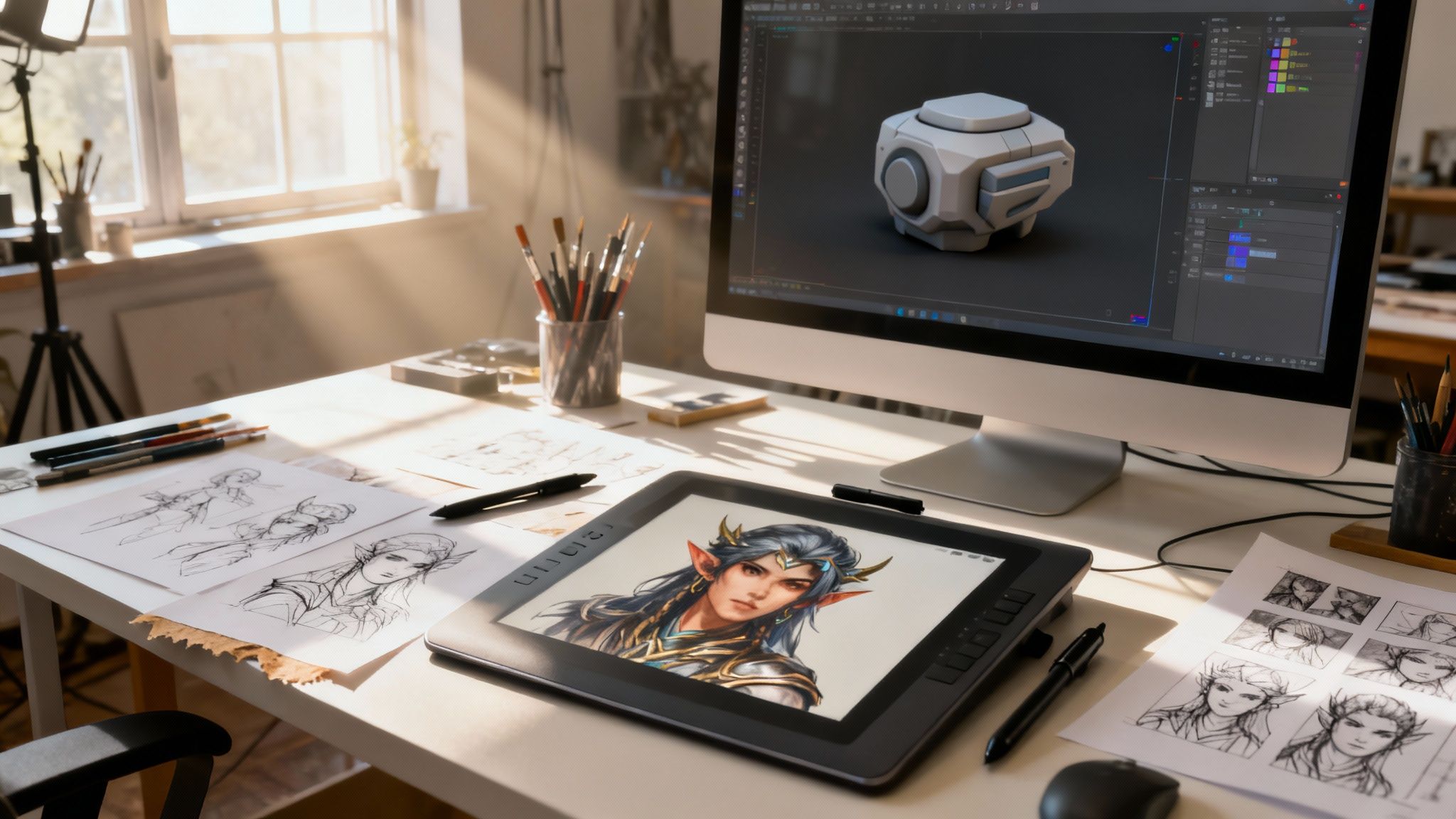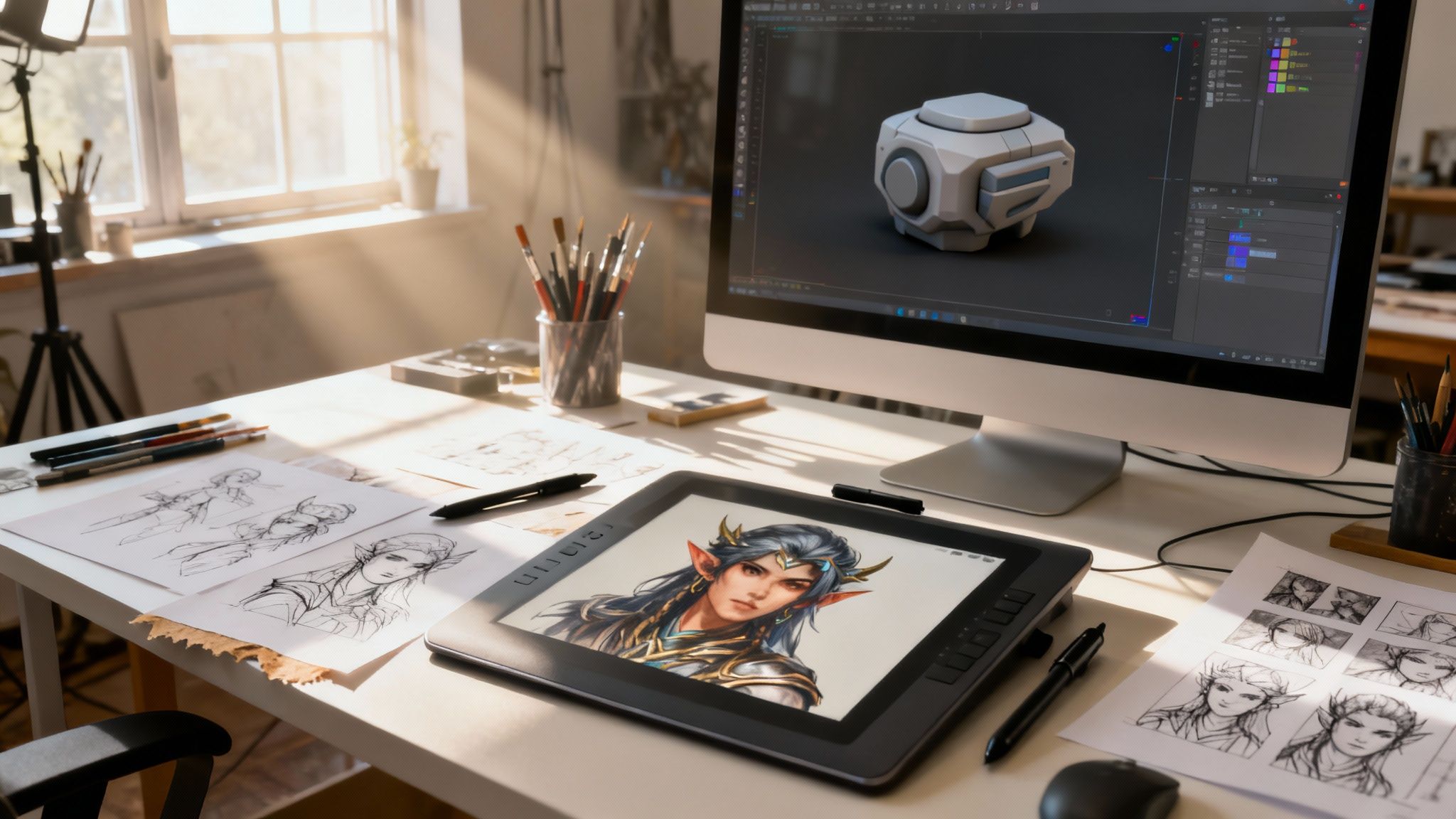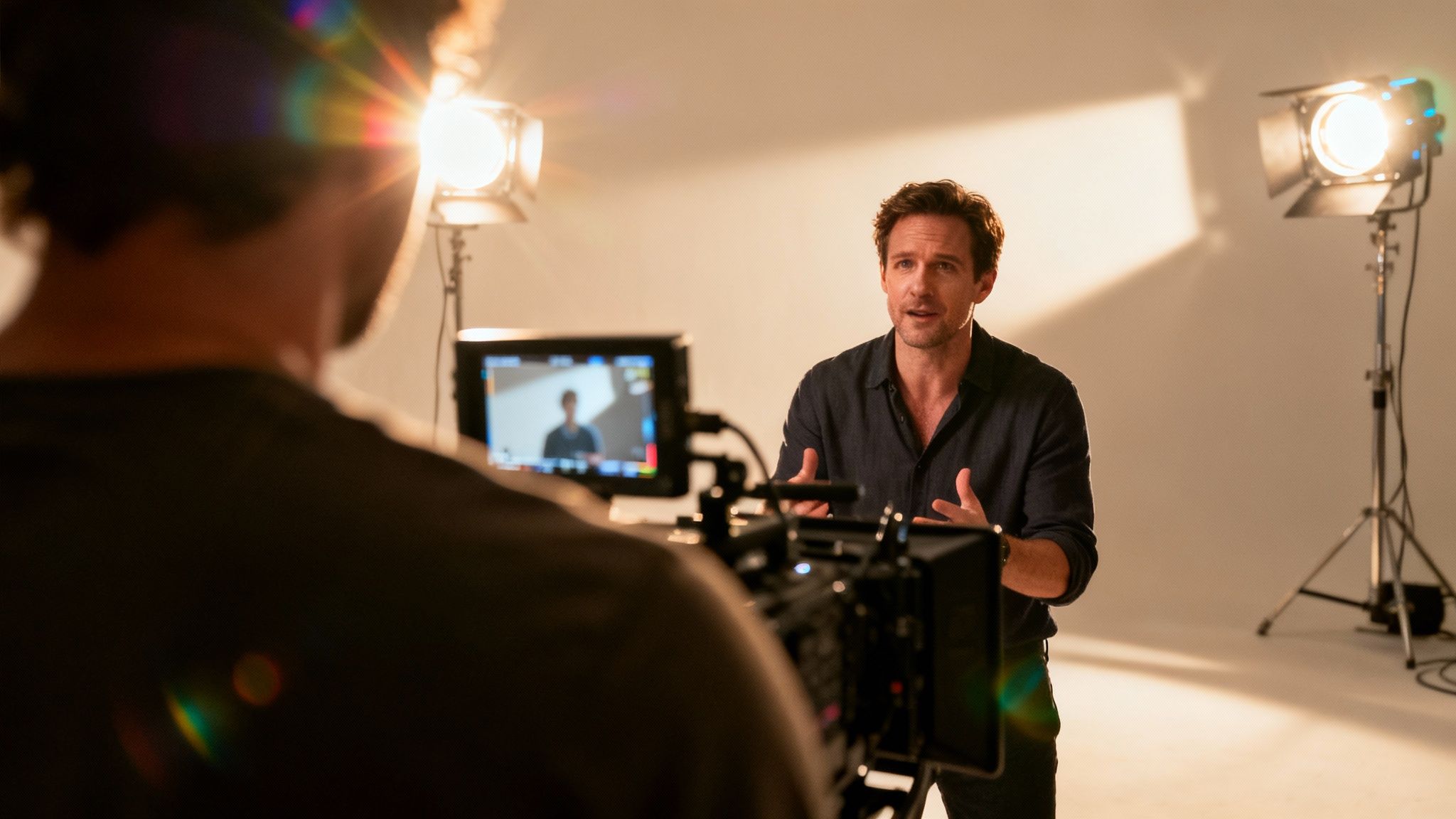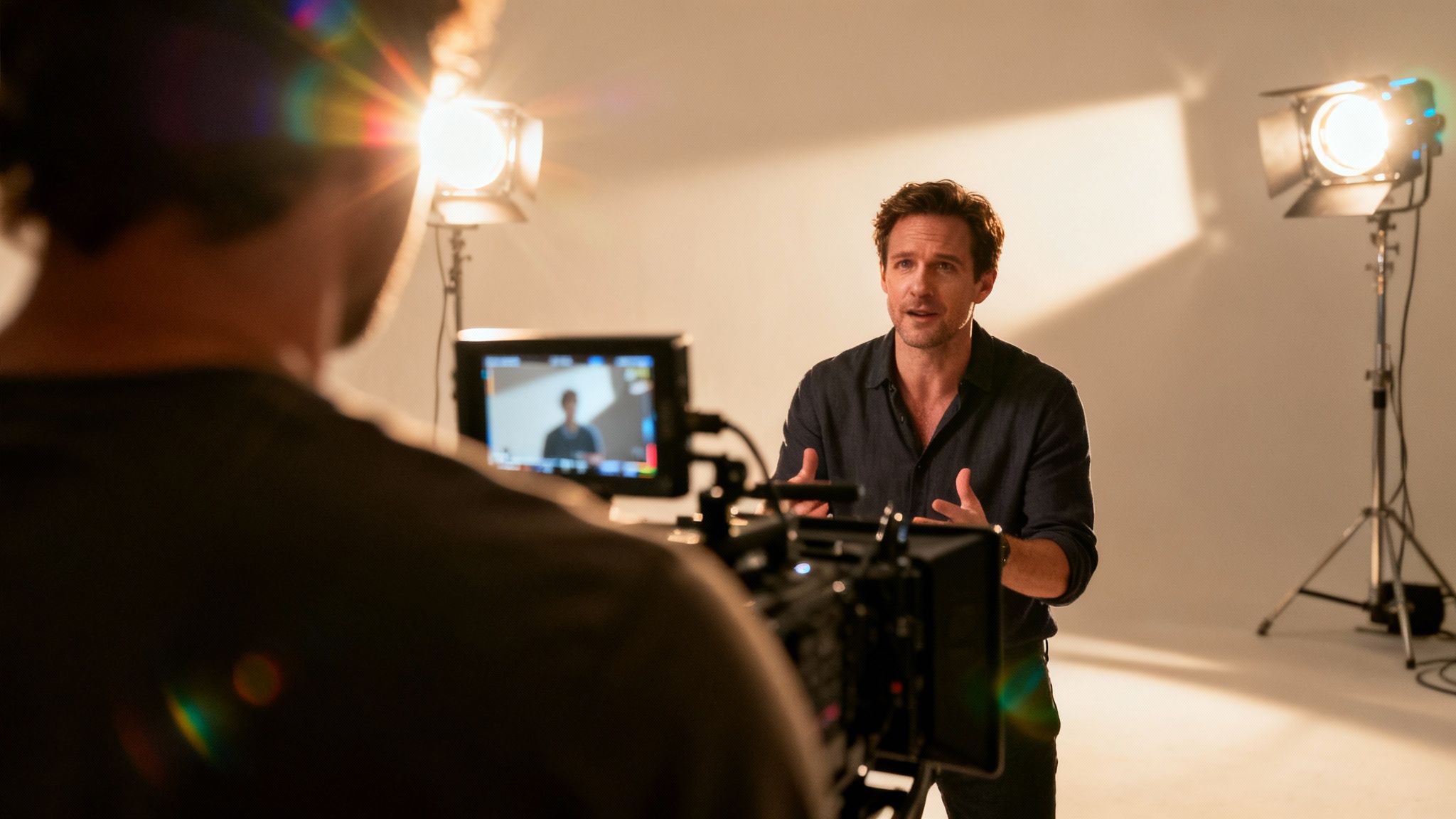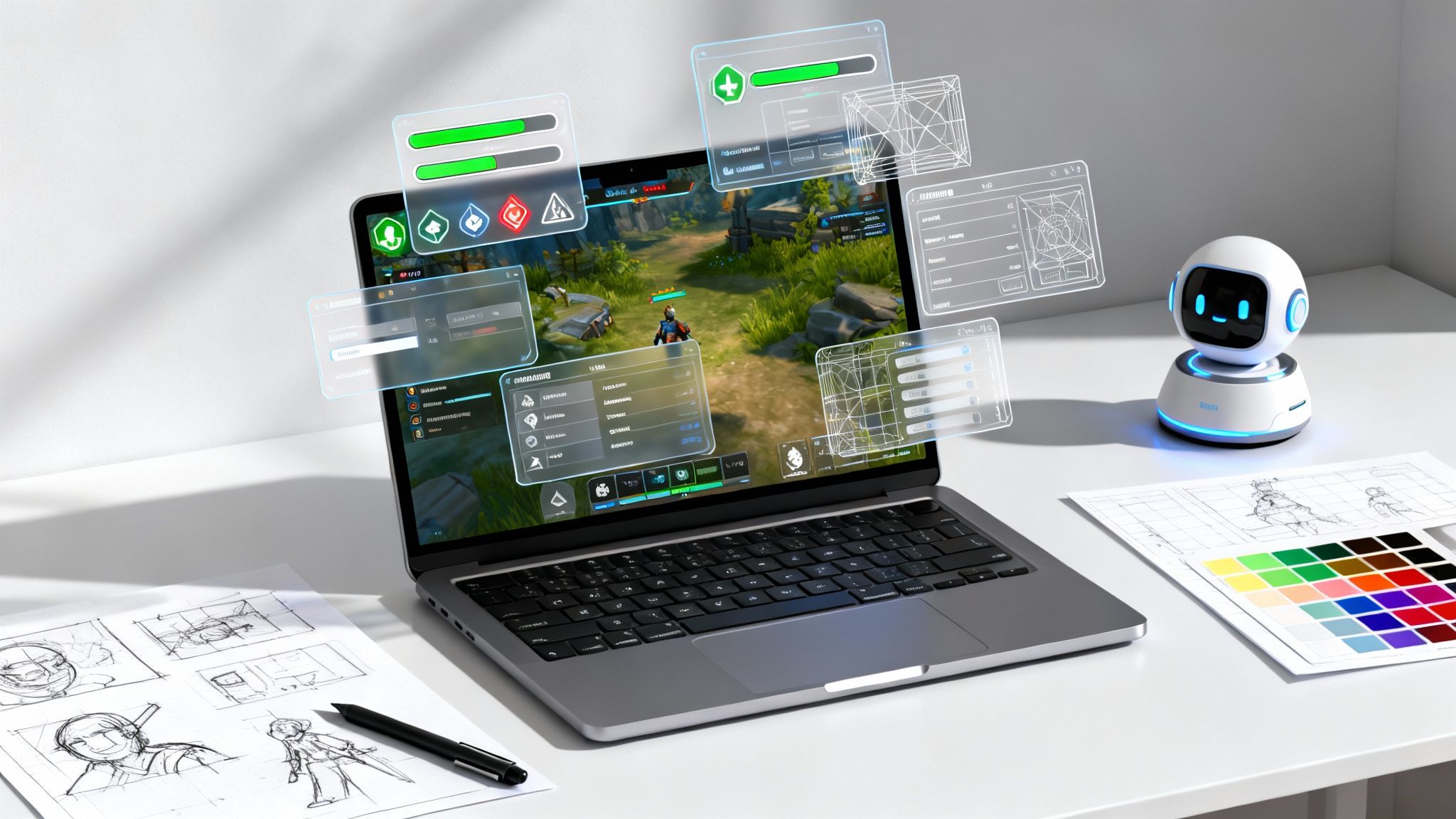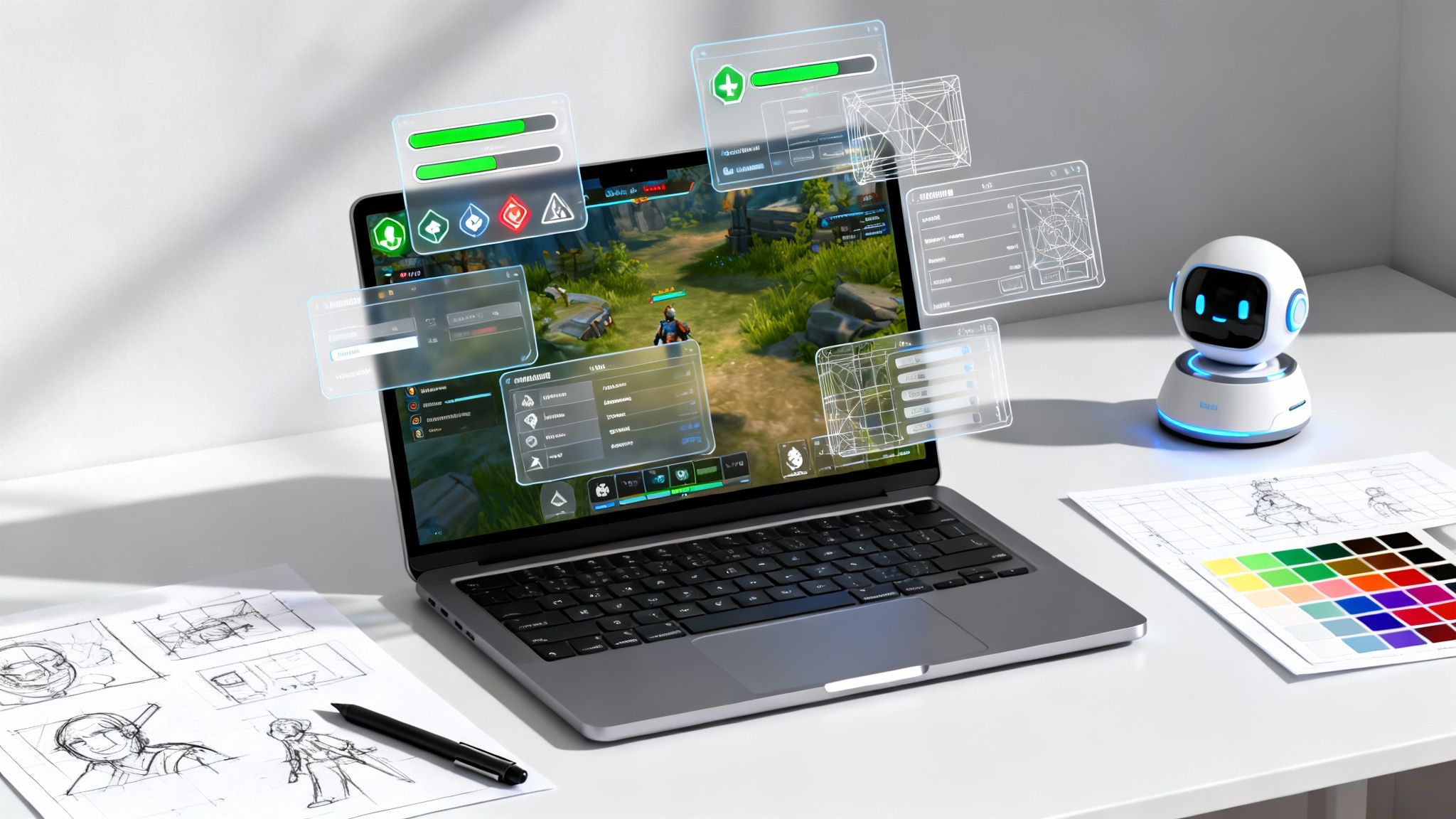Concept art is the foundational pillar of a game's visual identity. It's not just about creating impressive characters or landscapes; it's a practical, problem-solving discipline that occurs before a single 3D model is built. It serves as the visual blueprint that translates a director's abstract ideas into a tangible vision the entire team can understand and execute.
This initial work is crucial for keeping the project aligned, ensuring everyone—from modelers to animators to level designers—is working toward the same goal.
Establishing the Vision for Your Game Art
Every great game begins with an idea, but an idea alone is abstract. Concept art provides form and function, acting as the critical bridge between the initial spark and the final, playable world. It is the phase where the entire look and feel of the game are defined.
Executing this stage correctly can save hundreds of hours of rework later. When the entire team is aligned on the visual style from day one, subsequent creative decisions become simpler and more focused. This is where the creative brief becomes an essential tool.
Interpreting the Creative Brief
The creative brief is the project's guiding document. It outlines the game's genre, target audience, core gameplay mechanics, and narrative. The concept artist's role is to translate these words into a cohesive visual language.
To achieve this, it's important to ask targeted questions that connect the art directly to the player's experience:
- Gameplay and Function: How must this character move? Is this environment a constrained corridor or an expansive, open world? The function of an asset should always inform its design.
- Narrative and Emotion: What feeling should the player experience in this scene? A horror game's abandoned hospital requires a vastly different color palette and shape language than a bright, welcoming village in an RPG.
- Audience and Tone: Who is the intended audience? A stylized, chunky art style might be appropriate for younger players, while a gritty, realistic aesthetic could be better suited for a mature, narrative-driven game.
The infographic below illustrates how to solidify this direction by building a mood board and visual library.
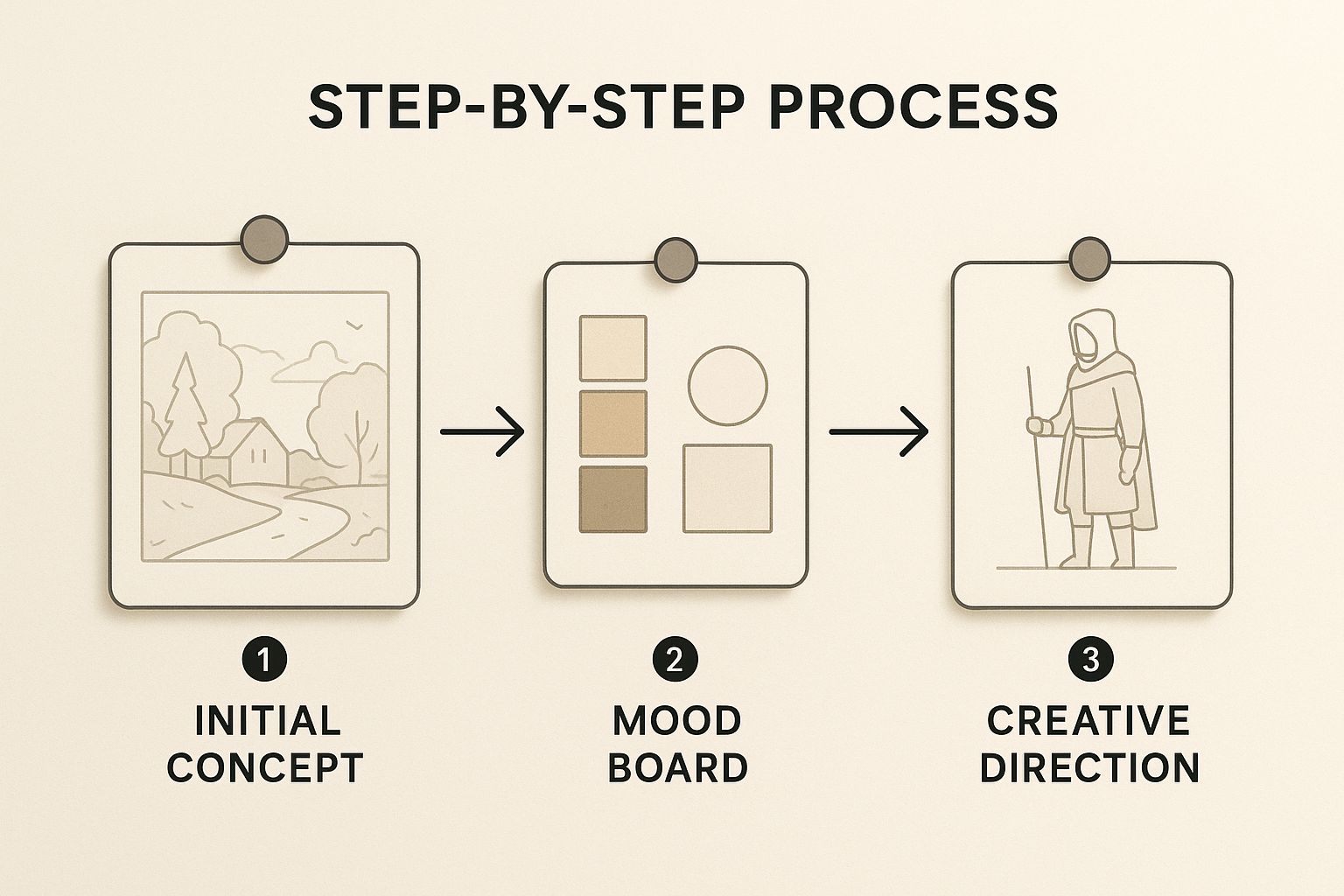
This process involves gathering references, exploring color palettes, and defining a clear shape language that serves as the foundation for all subsequent artwork.
Building a Strong Visual Foundation
Once the brief has been thoroughly analyzed, the next step is to build a visual library, often in the form of a mood board. This is not a random collection of images; it is a curated set of visuals, textures, and real-world references that collectively define the game's intended art style. It is an essential tool for maintaining consistency across the art team.
The demand for artists skilled in this process is growing in line with the industry itself. The global gaming market's revenue increased from $184 billion in 2023 to $187.7 billion in 2024, creating a significant need for immersive worlds.
Furthermore, the game art services market is projected to reach $6 billion by 2033, which highlights the critical importance of the foundational concept art phase. You can explore more data on the gaming industry's growth to understand the scale of the opportunity.
A well-defined vision is the most valuable asset in game development. It aligns the team, clarifies creative decisions, and ensures the final product is a cohesive and compelling experience for the player.
Developing Ideas from Thumbnails to Sketches
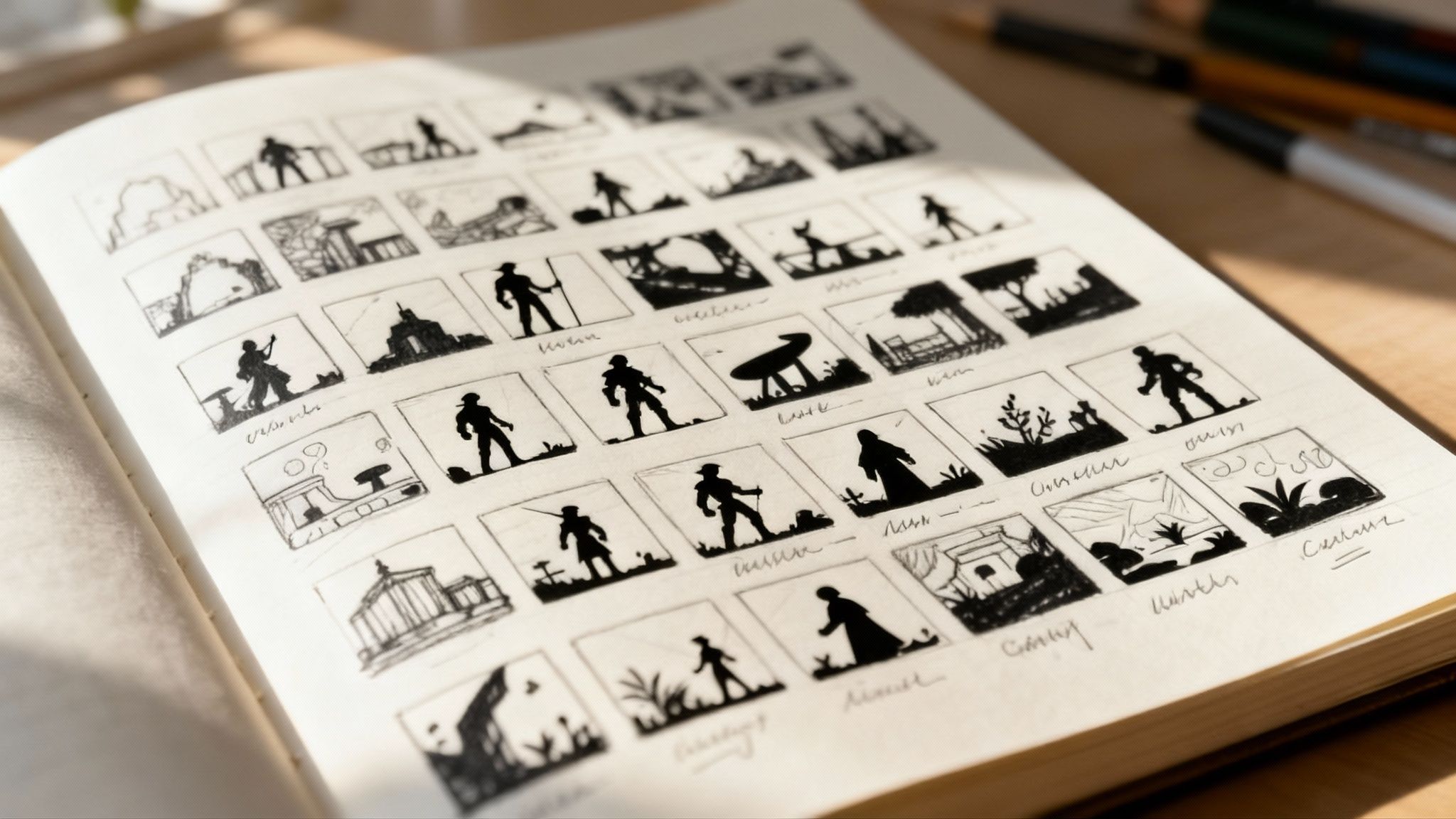
With the core vision established, the process of turning abstract ideas into tangible visuals begins. This hands-on creation phase does not start with a single, detailed drawing.
Instead, it begins with rapid, low-pressure exploration. The goal is not to create a masterpiece on the first attempt, but to generate as many possibilities as quickly as possible.
This initial stage is known as thumbnail sketching. These are small, rough drawings used to explore dozens of concepts for characters, environments, or props without getting bogged down in details. It is a form of visual brainstorming.
The Power of Rapid Ideation
Working quickly and loosely is key. The focus is not on clean lines or perfect anatomy but on capturing the overall impression. This approach prevents attachment to a weaker idea simply because significant time was invested in it.
The strongest ideas often emerge after multiple iterations. The objective is to produce images with clear intent, focusing on powerful silhouettes and dynamic compositions.
For instance, when designing a new enemy, an artist might generate 30 different body shapes in 30 minutes. Some may be tall and slender, while others are short and robust. This process helps discover the visual language that communicates "fast, agile threat" versus "slow, heavy bruiser."
From Strongest Thumbnail to Refined Sketch
After creating a page of thumbnails, the artist and art director collaborate to select the most promising options. Often, the final concept is a hybrid, combining the best elements from several different sketches. The head from one thumbnail might be paired with the body of another.
Once a direction is chosen, the selected thumbnail is developed into a more detailed sketch. Here, the design is fleshed out, with secondary shapes, clarified forms, and key features defined. As the process moves from a rough idea to a more concrete drawing, cultivating attention to detail becomes critical. It distinguishes a good concept from a production-ready one.
A strong silhouette is the foundation of memorable game character design. If a character is recognizable from its shadow alone, you've created something iconic and readable for the player.
Communicating Function Through Design
Every design element should serve a purpose. In game art, visuals must communicate narrative and gameplay function instantly. Shape language is a powerful tool for this.
- Circles and curves typically signal friendliness, safety, or organic forms. Consider a helpful NPC's rounded features or the rolling hills of a peaceful village.
- Squares and rectangles communicate stability, strength, and man-made structures. This is common in military designs, architecture, and stoic, immovable characters.
- Triangles and sharp angles are a universal sign of danger, aggression, and speed. Villains, monsters, and high-performance vehicles often use this language.
A practical example comes from the developers of Warhammer 40,000: Darktide. They discovered that the shoulder and head areas had the greatest impact on enemy identification. By adding distinct elements like a welder's mask for the Mauler and a unique gas mask for the Trapper, they made each threat instantly recognizable. This illustrates how small design choices can have a significant impact on gameplay.
To provide a clearer picture, here is a breakdown of how these pieces typically come together.
Key Stages in a Game Concept Art Workflow
This table outlines the typical journey of a concept art piece, from an initial idea to a final illustration ready for the 3D team.
Each step builds on the last, ensuring the final design is not only visually appealing but also perfectly aligned with the game's functional requirements.
Building a Modern Digital Painting Workflow
Once a sketch is approved, the digital painting phase begins. An efficient workflow is a hallmark of a professional artist. A modern process is not about rigid rules but about a flexible system that allows for quick iteration and high-quality delivery.
First, it is important to set up the digital canvas correctly. Much of the industry uses tools like Adobe Photoshop, so we will focus there. Ensure your machine is capable by reviewing what's involved in meeting Adobe Photoshop system requirements—technical lag can disrupt creative flow.
Organizing Your Digital Workspace
An organized file is an efficient file. The foundation of a professional, non-destructive workflow is solid layer organization. This approach allows changes to be made at any point without permanently altering the original painting, which is invaluable in a studio environment where feedback is continuous.
It is good practice to create layer groups for the major elements of a piece from the outset. For a character concept, this might look like:
- Atmosphere: For fog, dust, smoke, or background lighting effects.
- Character: Containing nested groups for the head, armor, weapons, etc.
- Foreground Elements: Anything positioned in front of the character.
- Background: The environment or scene behind the character.
This structure enables the isolation and adjustment of specific parts of the image quickly. If an art director requests a different armor color, it can be adjusted in moments without affecting other elements.
A well-organized layer structure is your safety net. It empowers you to experiment freely and respond to feedback efficiently, turning potential hours of rework into a simple adjustment.
Blocking In Color and Light
With layers organized, the next step is to establish the foundational colors and lighting. This is often called color blocking or laying in "flats." Details are not the focus at this stage. The goal is to lay down the main local colors for each part of the design, ensuring each color is on a separate layer within its respective group.
Once base colors are in place, light and shadow can be built up. A common professional technique is to use adjustment layers like Curves or Levels and clip them to the base color layers. This allows for control over highlights and shadows without painting directly on the flats.
For example, a new layer set to the "Multiply" blending mode can be used to paint in core shadows, while another set to "Overlay" or "Soft Light" can be used for highlights. This non-destructive method keeps all options open for future adjustments.
Rendering and Material Definition
The rendering phase is where the design is made to look believable. This is where an understanding of light, form, and texture is crucial. Custom brushes are valuable for creating compelling surfaces. An artist might use a hard-edged chalk brush to define the planes of a rock face and a textured spatter brush to add grime to metal armor.
Creating believable materials is what sells your concept art for games.
- Worn Metal: Combine hard and soft brushes. Start with a metallic base, add a darker layer for scratches with a thin, hard brush, and finish with soft highlights where light would catch the edges.
- Flowing Fabric: This is about using soft gradients to show folds. Use a large, soft airbrush for the main shapes and a smaller, slightly harder brush to define deeper creases and bright highlights.
- Organic Textures: For materials like skin, leather, or rock, layering different textured brushes builds complexity. Photobashing can be used for small, intricate surface details, but it is important to paint over them to integrate everything into the established style.
Many artists create their own textures from scratch. To improve material definition skills, you can learn more about creating seamless textures.
By combining disciplined organization with creative painting techniques, you can build a workflow that is both efficient and capable of producing portfolio-ready art.
Leveraging 3D and AI in Your Creative Process
The traditional concept artist's toolkit is undergoing a significant evolution. While fundamentals like design, color, and composition remain timeless, the integration of 3D and AI is reshaping creative workflows. These tools should be viewed as powerful assistants that handle tedious tasks and open up new creative avenues.
This allows artists to shift their focus from repetitive work to high-level creative problem-solving. Approximately one-third of developers are already using generative AI to accelerate parts of their pipeline. The result is more time spent on what matters most—design and innovation—while technology handles heavy lifting. You can learn more about these trends shaping the game industry and how studios are adapting.
Using AI as a Creative Spark
Consider AI as an ideation partner. When facing a creative block, AI can generate a multitude of visual ideas, from character costumes and environmental moods to unique material textures.
The key is to use it as a starting point, not as a final solution.
- Mood Boarding: Generate dozens of thematic images in minutes to establish a visual direction.
- Texture Generation: Create unique patterns for alien armor or ancient stonework, then refine and paint over them.
- Breaking Creative Blocks: If stuck on a weapon design, an AI can produce numerous rough concepts, providing a fresh perspective to build upon.
By integrating these tools, you are not just making art; you are directing a creative assistant. For a closer look at how studios are adopting this technology, review our guide on the role of AI in game development.
AI should augment your creativity, not automate it. The artist's eye for curation, storytelling, and design intent is what elevates a generated image into meaningful concept art.
Integrating 3D for Speed and Precision
While 2D painting remains central to concept art, incorporating 3D software like Blender into your workflow can dramatically increase speed and accuracy. This technique, often called 3D blockouts or kitbashing, provides a solid foundation for a final paintover.
Using a 3D base helps overcome one of the more challenging aspects of 2D art: achieving correct perspective and lighting for complex objects. Designing an intricate sci-fi vehicle with perfect perspective could take days in 2D. In a 3D program, a simple version can be assembled from basic shapes in hours, allowing for ideal camera angles and realistic lighting and shadows instantly.
From there, the image can be rendered and painted over. This hybrid approach combines the precision of 3D with the artistic freedom of 2D, serving as an effective bridge between an initial idea and the final 3D asset.
Presenting Your Work and Collaborating with Teams
Creating excellent concept art for games is only part of the process. The other part involves effectively communicating the idea. In a professional studio environment, artistic skill must be complemented by the ability to present work, accept feedback constructively, and integrate into a larger team.
Effective communication is a production necessity. It prevents costly misunderstandings that can derail projects and ensures the design intent is successfully translated into the final 3D asset. It is a key differentiator between a good artist and an indispensable team member.
Preparing Your Art for Presentation
Before showing your work to an art director or stakeholder, it must be packaged for clarity. This means going beyond a single image. The goal is to anticipate questions and answer them visually, leaving no room for ambiguity.
Callout sheets are an invaluable tool for this. These are versions of your concept art that include notes, diagrams, and specific details explaining the rationale behind design choices.
For a character, a callout sheet might detail:
- The exact material of their armor (e.g., "Scuffed iron with brass trim, not polished steel").
- The function of a specific gadget on their belt.
- Close-up views of small but important details, like an insignia or a facial scar.
This proactive communication facilitates a smooth handoff to the 3D artists. You are providing not just a drawing, but a comprehensive blueprint.
Receiving and Implementing Feedback
Feedback is not a critique of talent; it is a vital part of the collaborative process that elevates a design from good to great. The key is to listen, ask clarifying questions, and approach revisions with a problem-solving mindset rather than a defensive one.
Constructive criticism is a gift. It provides a different perspective that can unlock a design's true potential and ensure it aligns perfectly with the game's vision and gameplay needs.
When receiving notes, paraphrasing them back to the art director can confirm mutual understanding. This simple step can prevent hours of rework based on a misinterpretation. Maintaining organized project files is also crucial for making quick changes, so it is wise to follow best practices for effective digital asset management.
Working with External Studios and Partners
Modern game development often involves collaboration with specialized external partners. The growth in game art outsourcing is a significant trend, driven by the need for cost-effective solutions to manage the complexity of today's games. The global game art services market is valued at around $2 billion in 2025 as studios increasingly rely on external talent. You can find more on this in the game art outsourcing trends on RocketBrush.com.
When working with external teams, clear and professional communication is paramount. Callout sheets and documentation become essential. Since informal communication is limited, it is important to be concise, thorough, and provide all necessary information upfront to ensure a successful partnership.
Got Questions About Game Concept Art?
As you begin your journey into concept art, questions will arise. This is normal. Whether you are deciding which software to learn or how to build a portfolio, getting reliable answers can save significant time and effort.
To assist, here is some straightforward advice for the most common questions artists ask when entering the games industry.
Your Career, Your Tools
A frequent question pertains to software. Adobe Photoshop remains the industry standard. It is a versatile tool capable of handling nearly any task required in the field.
For those on a budget, Procreate is an excellent, more affordable option that offers a natural feel for sketching and painting. As 3D becomes more integrated into the 2D workflow, Blender is an invaluable tool. It is free, open-source, and ideal for blocking out shapes and prototyping ideas.
Another common question is whether an art degree is necessary. While a degree can provide a solid foundation and valuable connections, studios ultimately hire based on portfolios, not diplomas. A strong portfolio that showcases skill, design sense, and creative thinking will always be the most important asset.
Your portfolio is everything. It's your voice, your resume, and your proof that you can deliver professional-quality work that fits right into a game development pipeline.
Finding Your Niche and Building a Killer Portfolio
Eventually, you will consider whether to specialize. Should you focus on characters, environments, or props?
Generalists are highly valuable, especially at smaller studios where team members often take on multiple roles. However, at larger companies, a deep specialty can make you a stronger candidate for specific positions. A recommended approach is to start by building a solid foundation across all areas, then specialize in the area you are most passionate about.
Finally, let's discuss building a portfolio that leads to employment. The guiding principle is quality over quantity. A portfolio with five outstanding, polished pieces is far more effective than one with twenty mediocre ones.
Showcase your absolute best work. Include personal projects that reflect your unique style, but also include pieces that demonstrate your ability to work within specific artistic constraints. This combination of creative passion and technical flexibility is what makes a portfolio stand out.
Ready to unify your entire creative process? Virtuall is the AI-powered Creative OS that brings 3D, image, and video generation into a single, collaborative workspace. Move from concept to final asset faster than ever at https://virtuall.pro.

